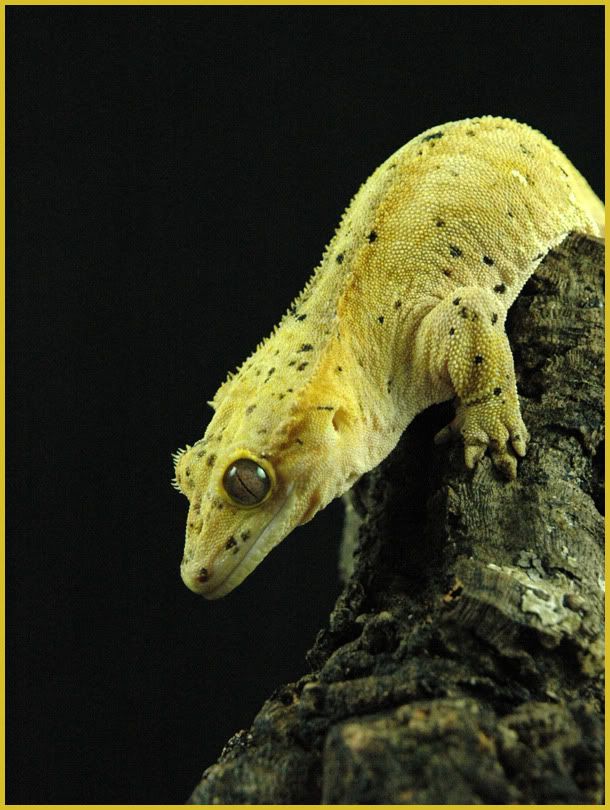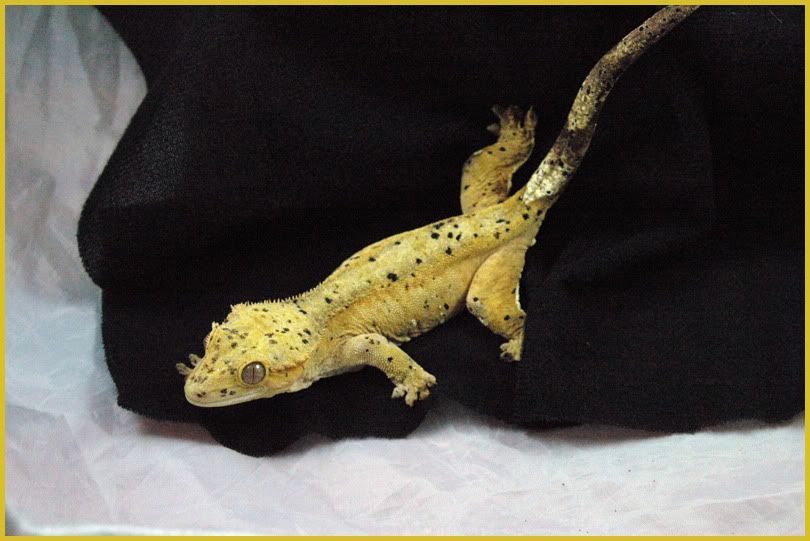Since I do so love Jeff Foxworthy, and his "You might be a redneck if..." commentary, I decided to start a list of my own. Without further ado, "You might be a reptile person if..."
...You go digging through the recyclables to save plastic water bottle lids, toilet paper tubes, and egg crates.
...You go to bed sweating because it's become more efficient to heat the entire house than individual tanks.
...To you, Tupperware means 'sauna', not 'leftovers'.
...You wonder why anyone would buy the glass starter tanks, because clearly they aren't stack-able.
...You get irritated at a ten minute drive to the grocery store for food, but a four hour trip to the next expo seems perfectly reasonable.
...You can understand why someone would breed roaches.
...You've ever had to move the rats to get to your ice cream.
...When someone says, "Nice rack!", you look for a caging system.
...Similarly, "That guy has awesome balls," does not sound like an obscene reference to you.
...When the news reports a python on the loose, anything under 8' makes you shrug dismissively.
...You know why people hate shipping from California.
...You've ever looked at your collection and thought, "Hm, guess I'm not moving to Hawaii."
...The animals in your home have three different categories: Pets, Breeders, and Feeders.
...You actually have a species wishlist.
...You know the difference between UVA and UVB, and what the purpose of vitamin D3 is.
...And you actually care.
...The term, "Sperm Retention" means something to you.
...You see your friends will all of their cute, cuddly, furry, affectionate animals and don't really see the attraction.
...You catch yourself correcting people on the difference between a turtle and a tortoise.
...You've ever rolled your eyes about amphibians being lumped into the same category as tortoises, snakes, and lizards.
....You can explain to the person sitting next to you why they wouldn't be.
...You know that male snakes don't have a penis.
...You thought to yourself after that last one, "Great, now we're going to have yet another thing to clear up with all of the non-reptile people...."
Thursday, December 8, 2011
Saturday, September 3, 2011
Snake Pee and Smelling Salts
This journal entry was originally written on July 29th of 2010, while my reptiles and I were still residing in a single bedroom of my parents home. While the count of the animals fluctuates, and I now keep them outside of my bedroom, the sentiment remains the same. Enjoy!
--
Living in close quarters with animals will teach you nothing if not patience. As it currently stands (after a few unexpected losses, and downsizing for the move), I share my bedroom with three Ball Pythons, sixteen Crested Geckos, and one Leopard Gecko. One can only imagine what the room has looked like over the past sixteen years, constantly transforming to accommodate yet another tank when, just after adding the last one, I swore to myself that there was 'absolutely, positively, no more room.'
A light sleeper in general, I have (over time) become much more adept at continuing to snooze straight through the various bumps, thumps, rustles, clicks, chirps, thunks, and other assorted noises in the night. The one thing I have not adjusted to is... snake pee. (Henceforth referred to by its scientific name, 'urates'.)
Currently, my bed is lofted six feet into the air to allow myself some actual living storage space; all said and done, I use the area under my bed for supplies and clothing, and sleep roughly 18" from the ceiling. Sleeping quarters are cramped, with poor air circulation and heat issues - or, as I call it, "cozy".
It is not quite so 'cozy' at two o'clock in the morning, when I have suddenly come from REM sleep to full consciousness at lightning speed, only to discover that my sinuses and lungs are ON FIRE and I can barely breathe.
Between the nocturnal nature of the animals I keep, the natural out-gassing of waste products, and the very poor circulation of air around my head at night, I regularly find myself waking up in just such a manner. There's no polite way to say it - urates STINKS. It is, basically, a waste form of ammonia; ammonia, as you may or may not know, is the main ingredient in smelling salts. It has become no real surprise to the rest of my family to discover me up and scrubbing tanks in my boxer shorts at three a.m., or crashed on the futon in the living room for the night with my bedroom window open until the area becomes 'livable' again. (It also helps explain why all of the animals are in my room - it's tough to make an argument for having any part of the rest of the house smell like that. Maybe we could keep them in the bathroom?)
It also makes it obvious that the only people who keep animals like that are people that love them.
I have heard many people exclaim, "Oh, isn't it darling!" about a newborn baby - and maybe, to some, it is; wrinkly, purple, crying and screaming and smelling of sour-milk-y vomit... Adorable. For the most part, though, I think there's something about that statement that rings most true for the mother and father; the ones that have been up all night feeding it, changing its diapers, burping it, and singing it back to sleep as best as they can - the ones that changed their lives to have it in their homes.
That's how it is for me with my reptiles; where many people look at them and see a scaly representation of evil itself (which is sometimes how I view newborns, so I'll call it an even trade), I see my own version of a kid - the thing I've worked my life around to keep.
--
Living in close quarters with animals will teach you nothing if not patience. As it currently stands (after a few unexpected losses, and downsizing for the move), I share my bedroom with three Ball Pythons, sixteen Crested Geckos, and one Leopard Gecko. One can only imagine what the room has looked like over the past sixteen years, constantly transforming to accommodate yet another tank when, just after adding the last one, I swore to myself that there was 'absolutely, positively, no more room.'
A light sleeper in general, I have (over time) become much more adept at continuing to snooze straight through the various bumps, thumps, rustles, clicks, chirps, thunks, and other assorted noises in the night. The one thing I have not adjusted to is... snake pee. (Henceforth referred to by its scientific name, 'urates'.)
Currently, my bed is lofted six feet into the air to allow myself some actual living storage space; all said and done, I use the area under my bed for supplies and clothing, and sleep roughly 18" from the ceiling. Sleeping quarters are cramped, with poor air circulation and heat issues - or, as I call it, "cozy".
It is not quite so 'cozy' at two o'clock in the morning, when I have suddenly come from REM sleep to full consciousness at lightning speed, only to discover that my sinuses and lungs are ON FIRE and I can barely breathe.
Between the nocturnal nature of the animals I keep, the natural out-gassing of waste products, and the very poor circulation of air around my head at night, I regularly find myself waking up in just such a manner. There's no polite way to say it - urates STINKS. It is, basically, a waste form of ammonia; ammonia, as you may or may not know, is the main ingredient in smelling salts. It has become no real surprise to the rest of my family to discover me up and scrubbing tanks in my boxer shorts at three a.m., or crashed on the futon in the living room for the night with my bedroom window open until the area becomes 'livable' again. (It also helps explain why all of the animals are in my room - it's tough to make an argument for having any part of the rest of the house smell like that. Maybe we could keep them in the bathroom?)
It also makes it obvious that the only people who keep animals like that are people that love them.
I have heard many people exclaim, "Oh, isn't it darling!" about a newborn baby - and maybe, to some, it is; wrinkly, purple, crying and screaming and smelling of sour-milk-y vomit... Adorable. For the most part, though, I think there's something about that statement that rings most true for the mother and father; the ones that have been up all night feeding it, changing its diapers, burping it, and singing it back to sleep as best as they can - the ones that changed their lives to have it in their homes.
That's how it is for me with my reptiles; where many people look at them and see a scaly representation of evil itself (which is sometimes how I view newborns, so I'll call it an even trade), I see my own version of a kid - the thing I've worked my life around to keep.
Sunday, May 15, 2011
I sometimes indulge in shameless self promotion.
I've said it before, I'll say it again - the reptile industry isn't the one to get into if you're in it for the cash and prizes.
That said, it's a frickin' awesome hobby, especially during Spring!
If you don't know about my webpage yet, go ahead and check it out:
www.partygecko.com
You can also follow us on Facebook by going here:
http://www.facebook.com/partygecko#!/
That said, it's a frickin' awesome hobby, especially during Spring!
If you don't know about my webpage yet, go ahead and check it out:
www.partygecko.com
You can also follow us on Facebook by going here:
http://www.facebook.com/partygecko#!/
Monday, May 9, 2011
Saturday, April 23, 2011
DIY - Isolation/Hydration Station
Every once in a while, you're going to need to separate one of your animals from the others - whether it's a new arrival, an illness, an injury, aggression, etc. This can be done quickly and easily, for far less than the cost of setting up an entirely new tank. The DIY I'm showing here is designed for temporary use (generally for injury or hydration), since it's such a basic set-up, but it can be easily modified to suit your needs.
In this case, I'm showing you how to make a 'hydration station' for a Crested Gecko.
Since I'm working with smaller animals, I'm using a plastic shoe box that was given to me by a friend of mine - I've also used plastic tubs designed for storage, which can be used to accommodate larger animals.
As substrate, I've laid down a couple paper towels. Paper towels are an excellent substrate for hydration, as they hold quite a bit of moisture - they are also a great choice for juveniles of many species, as well as injured animals due to their cleanliness, ease of changing, and color (white, simple backgrounds are far easier to spot waste and other important to see items on).
I've misted heavily, and placed a food dish into the shoebox.

Using a paring knife, I poked several holes in the lid.
(Apologies for the angle, but it does show some of the holes better than a straight on view.)

Annnnnd... that's it.
Easy, huh? :)
Now, for a recovering animal, this is a pretty solid set up (add a water dish if they're going to be in there for more than a few hours, even with a heavy mist) - for an animal that just needs to be separated and is going to be in there for a prolonged period of time, use a larger space and add more decorations (paper towel and toilet paper tubes work well for a variety of species). Done and done. Quick, easy, and inexpensive.
In this case, I'm showing you how to make a 'hydration station' for a Crested Gecko.
Since I'm working with smaller animals, I'm using a plastic shoe box that was given to me by a friend of mine - I've also used plastic tubs designed for storage, which can be used to accommodate larger animals.
As substrate, I've laid down a couple paper towels. Paper towels are an excellent substrate for hydration, as they hold quite a bit of moisture - they are also a great choice for juveniles of many species, as well as injured animals due to their cleanliness, ease of changing, and color (white, simple backgrounds are far easier to spot waste and other important to see items on).
I've misted heavily, and placed a food dish into the shoebox.

Using a paring knife, I poked several holes in the lid.
(Apologies for the angle, but it does show some of the holes better than a straight on view.)

Annnnnd... that's it.
Easy, huh? :)
Now, for a recovering animal, this is a pretty solid set up (add a water dish if they're going to be in there for more than a few hours, even with a heavy mist) - for an animal that just needs to be separated and is going to be in there for a prolonged period of time, use a larger space and add more decorations (paper towel and toilet paper tubes work well for a variety of species). Done and done. Quick, easy, and inexpensive.
Sunday, April 17, 2011
A Horse Of Many Colors (aka: Before and After Photos)
One of the super interesting things about Crested Geckos - to me, anyway - is the amount of change in coloration that they can go through as they mature. I noticed this most dramatically with Norbert as I was looking through old files the other day, and as such, felt like posting a few progression shots.
This is Norbert shortly after I got him, weighing in at 4-5 grams.

This is Norbert as of last week, about three years after the original photo:

This is a gecko of mine, Zippo, when she weighed approximately 2-3 grams:
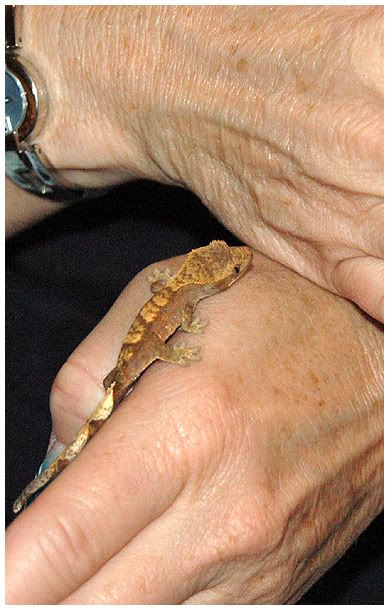
And this is the same gecko when she was approximately a year old (I'd post a photo of her today, but she never fires up so you can see her true colors anymore):

This is Norbert shortly after I got him, weighing in at 4-5 grams.

This is Norbert as of last week, about three years after the original photo:

This is a gecko of mine, Zippo, when she weighed approximately 2-3 grams:

And this is the same gecko when she was approximately a year old (I'd post a photo of her today, but she never fires up so you can see her true colors anymore):

Thursday, April 7, 2011
I Get Lizards In The Mail
Saturday, March 26, 2011
DIY - Naturalistic Background, No 'Great Stuff' Needed!
I'd be amazed if no one had thought of this before, but I personally haven't seen any threads about it, so here you go! They're quick, easy, and don't require the curing time or mess that great stuff and silicon do.
You will need:
-Your tank
-A pen of sorts for marking (I had a sharpie lying around so I used that)
-Strong scissors/wire cutters
-Hot glue gun&extra glue sticks
-Fake plants (I got mine from Michael's Arts&Crafts - it is important when selecting your plants that you make sure there are no sharp edges or little pieces that they could pull off&hurt themselves.)
-Contact Paper Cork Board (You can find several different brands, available in different places - I don't remember where I got mine, it might have been Orchard Supply Hardware. Here's a link to some that they have on amazon.com: http://www.amazon.com/Tact-04F-C6421-06-18-Inch-4-Feet-Adhesive/dp/B000WEPD6U/ref=sr_1_2?ie=UTF8&s=home-garden&qid=1301162045&sr=8-2
-Optional, Strongly Suggested: A good sense of humor
All the supplies, put together (oooh... ahhh... a visual aid...):
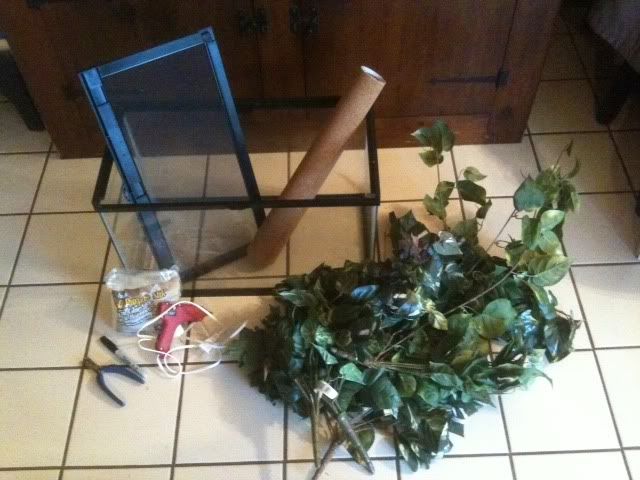
Pick the side that you want to decorate, and measure it out on the cork board. I'm working with scraps that I had left over, and managed to have just enough to cover that back wall of a 10 gal that I wanted to decorate. Draw your lines, then cut.
Personal recommendation: I like to cut the cork a little bit smaller than the dimensions of the side I'm putting it on, so that I know it will fit, and it gives me a little leeway with the plants and letting them stick over the edges. (For example, if the side was 18x24, I might cut the cork at 16x22)
Measure, draw, cut:
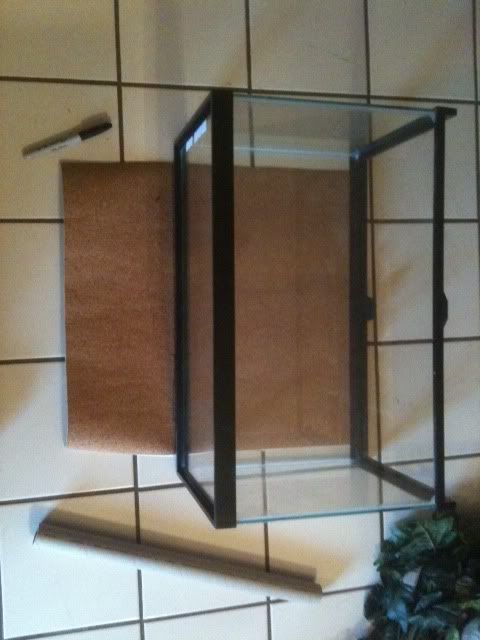
Plug in that hot glue gun, grab your fake plants, and start decorating!
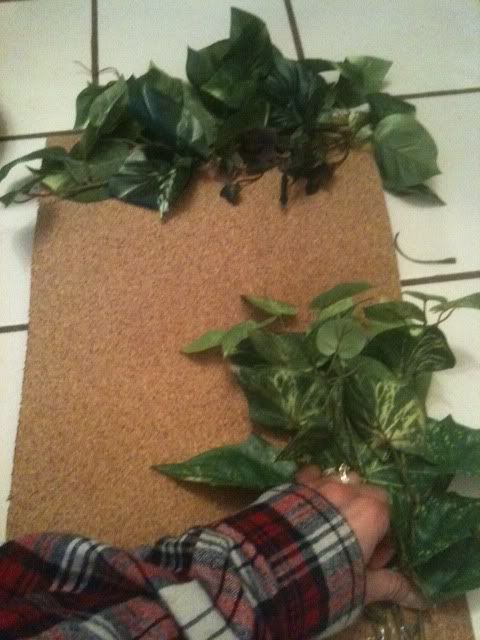
A couple 'rule of thumbs' that I like to keep in mind:
-With my geckos, "If it's not nailed down, they're going to tear it up." My critters /love/ these backgrounds, and it shows.
-Fabric is easier to glue than plastic. I always make sure to anchor the plants down by the 'stem', and then additionally by gluing a couple of the leaves to the cork as well.
-When in doubt, add more glue. It doesn't always have to be to the cork board - sometimes I'll glue one leaf to another well anchored leaf.
I like to rotate it a little, make sure I get a different view as I'm gluing stuff down, and 'over fill' the background a little - that's my own personal preference.
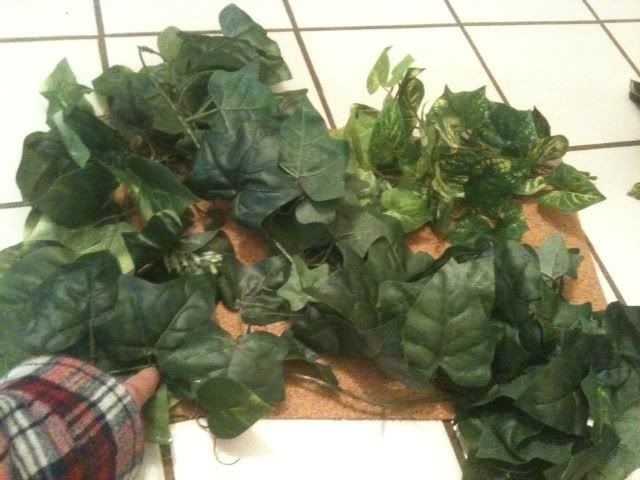
When I think the background looks full enough, or I'm done burning my fingers on the glue gun (which, for a ten gallon, takes about an hour), it looks something like this:
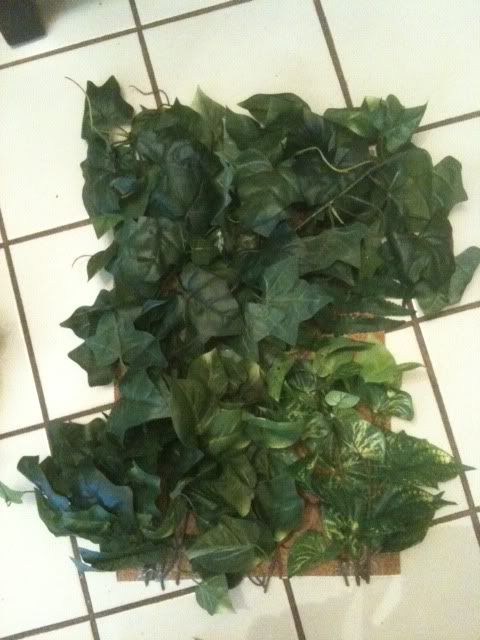
Turn it over, peel off the paper...
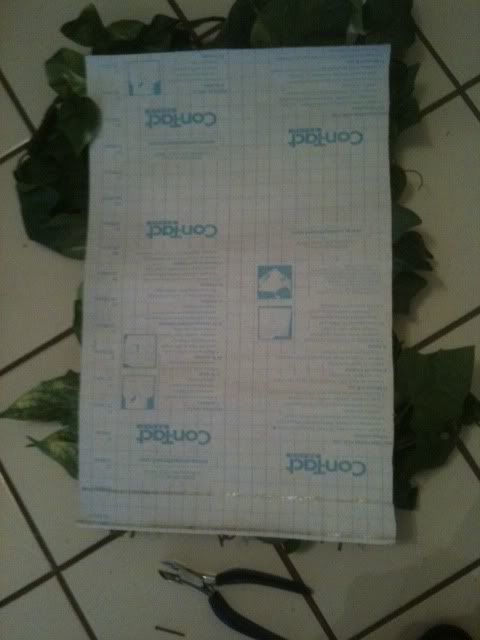
And press it onto the inside of the tank. Make sure to be very thorough, so that it adheres fully - I like to start from the center and work out, which helps to eliminate any air bubbles that might have gotten caught between the paper and the backing.
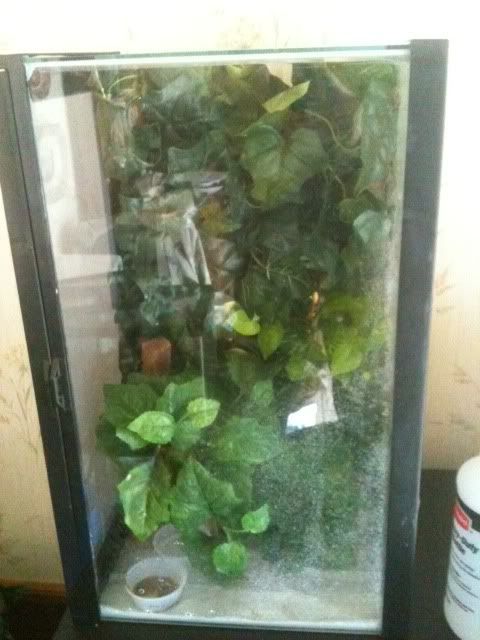
They're quick, easy, and hold up well to both the geckos and the humidity.
Hope this is helpful! :D
A gratuitous shot of the 20 L I did about 4 months ago:
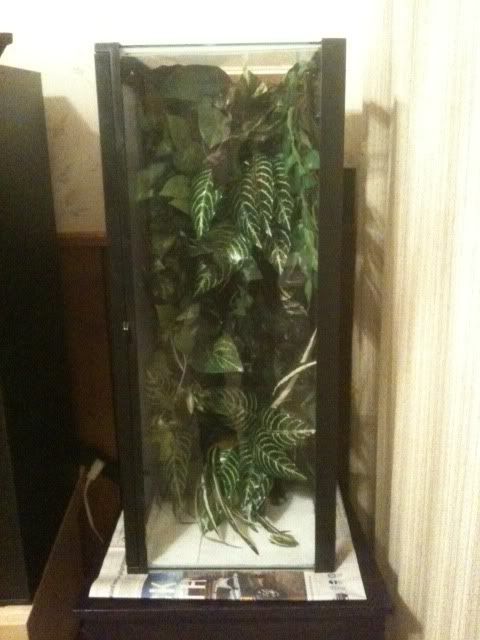
You will need:
-Your tank
-A pen of sorts for marking (I had a sharpie lying around so I used that)
-Strong scissors/wire cutters
-Hot glue gun&extra glue sticks
-Fake plants (I got mine from Michael's Arts&Crafts - it is important when selecting your plants that you make sure there are no sharp edges or little pieces that they could pull off&hurt themselves.)
-Contact Paper Cork Board (You can find several different brands, available in different places - I don't remember where I got mine, it might have been Orchard Supply Hardware. Here's a link to some that they have on amazon.com: http://www.amazon.com/Tact-04F-C6421-06-18-Inch-4-Feet-Adhesive/dp/B000WEPD6U/ref=sr_1_2?ie=UTF8&s=home-garden&qid=1301162045&sr=8-2
-Optional, Strongly Suggested: A good sense of humor
All the supplies, put together (oooh... ahhh... a visual aid...):

Pick the side that you want to decorate, and measure it out on the cork board. I'm working with scraps that I had left over, and managed to have just enough to cover that back wall of a 10 gal that I wanted to decorate. Draw your lines, then cut.
Personal recommendation: I like to cut the cork a little bit smaller than the dimensions of the side I'm putting it on, so that I know it will fit, and it gives me a little leeway with the plants and letting them stick over the edges. (For example, if the side was 18x24, I might cut the cork at 16x22)
Measure, draw, cut:

Plug in that hot glue gun, grab your fake plants, and start decorating!

A couple 'rule of thumbs' that I like to keep in mind:
-With my geckos, "If it's not nailed down, they're going to tear it up." My critters /love/ these backgrounds, and it shows.
-Fabric is easier to glue than plastic. I always make sure to anchor the plants down by the 'stem', and then additionally by gluing a couple of the leaves to the cork as well.
-When in doubt, add more glue. It doesn't always have to be to the cork board - sometimes I'll glue one leaf to another well anchored leaf.
I like to rotate it a little, make sure I get a different view as I'm gluing stuff down, and 'over fill' the background a little - that's my own personal preference.

When I think the background looks full enough, or I'm done burning my fingers on the glue gun (which, for a ten gallon, takes about an hour), it looks something like this:

Turn it over, peel off the paper...

And press it onto the inside of the tank. Make sure to be very thorough, so that it adheres fully - I like to start from the center and work out, which helps to eliminate any air bubbles that might have gotten caught between the paper and the backing.

They're quick, easy, and hold up well to both the geckos and the humidity.
Hope this is helpful! :D
A gratuitous shot of the 20 L I did about 4 months ago:

Labels:
amphibian,
background,
corkboard,
DIY,
easy,
naturalistic,
plastic,
quick,
reptile,
tanks
Thursday, March 24, 2011
Seeing Spots
Well, tonight marks the 'official' retiring of my first breeding trio. (This may be retracted at a later date, but for now, it stands.)
Emerson, Zippo, and Honey will most likely live out the rest of their lives as 'pet only' ladies, luxuriating in restful days of lapping up Crested Gecko Diet, hanging from the glass walls of the tanks, and never having to look at a male again.
That said, I do plan on continuing to breed Cresties, at least for another year. I redid the reptile wall this evening; set a 20 Gallon Long on its end, creating a new home for one of my male Crested Geckos, Norbert (more on this tank and its backing later), and removed Lillun (the male that was in with the girls for the past few seasons) so that he now has his own enclosure.
Norbert is what they call a Super Dalmation color morph, meaning that he has over 100 spots on his body.



Earlier this week, I purchased a girlfriend for him - another Super Dalmation - and she can be seen here:
http://www.crownjewelreptiles.com/animals/view/26#
They should produce some very, very spotty babies, with some great crest structure and body size.
The offspring of Dalmation morph geckos tend to reflect the parents, and then some - being that both mom and dad have 100+ spots, the babies should definitely be some lookers.
I can hardly wait. :D
Emerson, Zippo, and Honey will most likely live out the rest of their lives as 'pet only' ladies, luxuriating in restful days of lapping up Crested Gecko Diet, hanging from the glass walls of the tanks, and never having to look at a male again.
That said, I do plan on continuing to breed Cresties, at least for another year. I redid the reptile wall this evening; set a 20 Gallon Long on its end, creating a new home for one of my male Crested Geckos, Norbert (more on this tank and its backing later), and removed Lillun (the male that was in with the girls for the past few seasons) so that he now has his own enclosure.
Norbert is what they call a Super Dalmation color morph, meaning that he has over 100 spots on his body.



Earlier this week, I purchased a girlfriend for him - another Super Dalmation - and she can be seen here:
http://www.crownjewelreptiles.com/animals/view/26#
They should produce some very, very spotty babies, with some great crest structure and body size.
The offspring of Dalmation morph geckos tend to reflect the parents, and then some - being that both mom and dad have 100+ spots, the babies should definitely be some lookers.
I can hardly wait. :D
Saturday, March 19, 2011
Hatching Them Is The Easy Part
Those of you that know me, know that I breed Crested Geckos. For those of you that don't know what those are, imagine a tiny, wingless, toothless dragon, whose temperament ranges somewhere between lap dog and apathetic house cat. Or, for those with a less creative imagination, look below:

When I entered into breeding these geckos a few years ago, my animals were competitive level breeders - their coloration and structure was worth noting and reproducing. It has now been a few years since I purchased these geckos; by today's standards, they generally have one quality worth reproducing (some have great patterning, some have awesome crest structure), but are no longer top of the line. Being that I have not invested in new geckos, the animals I'm producing are generally very high level pet quality, and in about 20% of them, breeding quality. For this very reason, this will likely be the last year that I use these geckos as breeders - I'm alright with producing pet quality (someone's got to cater to those who are really just looking for an awesome pet lizard), and keeping those that I don't sell off, and at the same time, I don't want to 'flood the market' with them. It's sort of like dogs - everyone wants something different, but you don't want too many of any one kind out there or people are going to start mistreating them.
If you're looking to get into breeding reptiles, it is important to consider why you want to do this. Is it to make oodles of money? I'll tell ya - breeding reptiles for the cash and prizes is like chewing bubble gum to win an algebra contest (minus the sore jaw). Are you breeding toward a particular goal? If so, are you willing to continue investing in purchasing breeding stock to keep pace with the evolution of the traits that you're shooting for? What are you going to do with the babies that don't fit into your breeding project? Reptiles need food, and space, and decorations, and care just like any other pet - only, they can be a lot harder to get off of your hands and into a new home. (I don't understand why, really - scaly babies are just as adorable as a teeny tiny fluffy bunny...) Are you breeding them just to see if you can do it? To hatch and raise your own babies?
My next project is going to be my Ball Python line. Back in 2008, I purchased two Lesser Platinum Ball Pythons - one male, one female - and I've spent the past few years growing them up into something of breeding age and weight. I bought these two with a particular goal in mind: I want to produce, hatch, and raise my own Blue Eyed Leucistic Ball Python. I may produce several clutches of Lesser Platinums before this occurs, and all of them will be breeding quality, because they are being bred for their coloration genes (Lesser Platinum is a color morph of a standard Ball Python) rather than a combination of traits (Crested Gecko breeding quality is based on the individual displaying a large collection of different visible traits).
Normal Ball Python (my pet-only sweetheart, Loki):
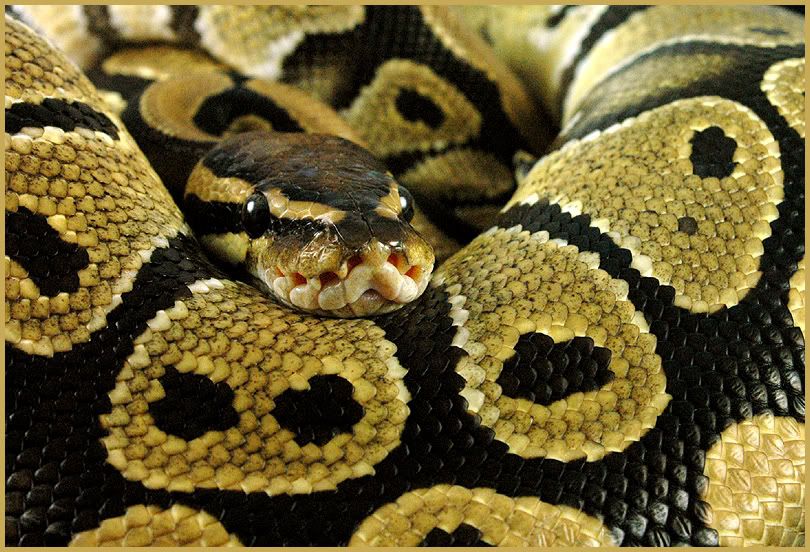
Lesser Platinum Ball Python (my female, Leyla):

Breeding reptiles is a constantly evolving (no pun intended) practice - it saves you a lot of time, energy, and money if you really do your research beforehand. It all comes down to responsibility, really. Get some background on the species that you want to breed, know /why/ you want to breed them, what sorts of projects other people are doing with the same species, have a plan for what you're going to do with the 'extra' babies, and - if push should come to shove - know that you need to be prepared to take care of every animal you produce.

When I entered into breeding these geckos a few years ago, my animals were competitive level breeders - their coloration and structure was worth noting and reproducing. It has now been a few years since I purchased these geckos; by today's standards, they generally have one quality worth reproducing (some have great patterning, some have awesome crest structure), but are no longer top of the line. Being that I have not invested in new geckos, the animals I'm producing are generally very high level pet quality, and in about 20% of them, breeding quality. For this very reason, this will likely be the last year that I use these geckos as breeders - I'm alright with producing pet quality (someone's got to cater to those who are really just looking for an awesome pet lizard), and keeping those that I don't sell off, and at the same time, I don't want to 'flood the market' with them. It's sort of like dogs - everyone wants something different, but you don't want too many of any one kind out there or people are going to start mistreating them.
If you're looking to get into breeding reptiles, it is important to consider why you want to do this. Is it to make oodles of money? I'll tell ya - breeding reptiles for the cash and prizes is like chewing bubble gum to win an algebra contest (minus the sore jaw). Are you breeding toward a particular goal? If so, are you willing to continue investing in purchasing breeding stock to keep pace with the evolution of the traits that you're shooting for? What are you going to do with the babies that don't fit into your breeding project? Reptiles need food, and space, and decorations, and care just like any other pet - only, they can be a lot harder to get off of your hands and into a new home. (I don't understand why, really - scaly babies are just as adorable as a teeny tiny fluffy bunny...) Are you breeding them just to see if you can do it? To hatch and raise your own babies?
My next project is going to be my Ball Python line. Back in 2008, I purchased two Lesser Platinum Ball Pythons - one male, one female - and I've spent the past few years growing them up into something of breeding age and weight. I bought these two with a particular goal in mind: I want to produce, hatch, and raise my own Blue Eyed Leucistic Ball Python. I may produce several clutches of Lesser Platinums before this occurs, and all of them will be breeding quality, because they are being bred for their coloration genes (Lesser Platinum is a color morph of a standard Ball Python) rather than a combination of traits (Crested Gecko breeding quality is based on the individual displaying a large collection of different visible traits).
Normal Ball Python (my pet-only sweetheart, Loki):

Lesser Platinum Ball Python (my female, Leyla):

Breeding reptiles is a constantly evolving (no pun intended) practice - it saves you a lot of time, energy, and money if you really do your research beforehand. It all comes down to responsibility, really. Get some background on the species that you want to breed, know /why/ you want to breed them, what sorts of projects other people are doing with the same species, have a plan for what you're going to do with the 'extra' babies, and - if push should come to shove - know that you need to be prepared to take care of every animal you produce.
Subscribe to:
Posts (Atom)










